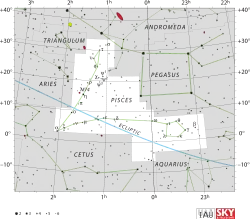Lambda Piscium
Lambda Piscium, Latinized from λ Piscium, is a solitary,[8] white-hued star in the zodiac constellation of Pisces. With an apparent visual magnitude of 4.49,[2] it is visible to the naked eye, forming the southeast corner of the "Circlet" asterism in Pisces. Based upon a measured annual parallax shift of 30.59 mas as seen from Earth,[1] it is located 107 light years distant from the Sun. Lambda Piscium is a member of the Ursa Major Stream, lying among the outer parts, or corona, of this moving group of stars that roughly follow a common heading through space.[9]
 | |
| Observation data Epoch J2000.0 Equinox J2000.0 (ICRS) | |
|---|---|
| Constellation | Pisces |
| Right ascension | 23h 42m 02.80612s[1] |
| Declination | +01° 46′ 48.1484″[1] |
| Apparent magnitude (V) | 4.49[2] |
| Characteristics | |
| Spectral type | A7 V[3] |
| U−B color index | +0.09[2] |
| B−V color index | +0.20[2] |
| Astrometry | |
| Radial velocity (Rv) | 6.7[4] km/s |
| Proper motion (μ) | RA: −129.70[1] mas/yr Dec.: −154.80[1] mas/yr |
| Parallax (π) | 30.59 ± 0.19[1] mas |
| Distance | 106.6 ± 0.7 ly (32.7 ± 0.2 pc) |
| Absolute magnitude (MV) | +1.92[5] |
| Details | |
| Mass | 1.806[3] M☉ |
| Radius | 2.0403±0.0451[3] R☉ |
| Luminosity | 13.3897±0.1692[3] L☉ |
| Surface gravity (log g) | 4.08[4] cgs |
| Temperature | 7,734±80[3] K |
| Metallicity [Fe/H] | 0.02[4] dex |
| Rotational velocity (v sin i) | 70[6] km/s |
| Age | 583±20[6] Myr |
| Other designations | |
| Database references | |
| SIMBAD | data |
This well-studied star[4] has a stellar classification A7 V,[3] indicating it is an A-type main-sequence star that is generating energy through hydrogen fusion at its core. It has 1.8 times the mass of the Sun and double the Sun's radius. The star is radiating 13.3 times the Sun's luminosity from its photosphere at an effective temperature of 7,734 K.[3] Lambda Piscium is around 583 million years old and is spinning with a projected rotational velocity of 70 km/s.[6]
Naming
In Chinese, 雲雨 (Yún Yǔ), meaning Cloud and Rain, refers to an asterism consisting of λ Piscium, κ Piscium, 12 Piscium and 21 Piscium. Consequently, the Chinese name for λ Piscium itself is 雲雨四 (Yún Yǔ sì, English: the Fourth Star of Cloud and Rain.)[10]
References
- van Leeuwen, F. (2007), "Validation of the new Hipparcos reduction", Astronomy and Astrophysics, 474 (2): 653–664, arXiv:0708.1752, Bibcode:2007A&A...474..653V, doi:10.1051/0004-6361:20078357, S2CID 18759600.
- Argue, A. N. (1966), "UBV photometry of 550 F, G and K type stars", Monthly Notices of the Royal Astronomical Society, 133 (4): 475–493, Bibcode:1966MNRAS.133..475A, doi:10.1093/mnras/133.4.475.
- Boyajian, Tabetha S.; et al. (July 2013), "Stellar Diameters and Temperatures. III. Main-sequence A, F, G, and K Stars: Additional High-precision Measurements and Empirical Relations", The Astrophysical Journal, 771 (1): 31, arXiv:1306.2974, Bibcode:2013ApJ...771...40B, doi:10.1088/0004-637X/771/1/40, S2CID 14911430, 40. See Table 3.
- Gebran, M.; et al. (May 2016), "A new method for the inversion of atmospheric parameters of A/Am stars", Astronomy & Astrophysics, 589: 10, arXiv:1603.01146, Bibcode:2016A&A...589A..83G, doi:10.1051/0004-6361/201528052, S2CID 118549566, A83.
- Anderson, E.; Francis, Ch. (2012), "XHIP: An extended hipparcos compilation", Astronomy Letters, 38 (5): 331, arXiv:1108.4971, Bibcode:2012AstL...38..331A, doi:10.1134/S1063773712050015, S2CID 119257644.
- Zorec, J.; Royer, F. (January 2012), "Rotational velocities of A-type stars. IV. Evolution of rotational velocities", Astronomy & Astrophysics, 537: A120, arXiv:1201.2052, Bibcode:2012A&A...537A.120Z, doi:10.1051/0004-6361/201117691, S2CID 55586789.
- "lam Psc". SIMBAD. Centre de données astronomiques de Strasbourg. Retrieved 2017-07-25.
- Eggleton, P. P.; Tokovinin, A. A. (September 2008), "A catalogue of multiplicity among bright stellar systems", Monthly Notices of the Royal Astronomical Society, 389 (2): 869–879, arXiv:0806.2878, Bibcode:2008MNRAS.389..869E, doi:10.1111/j.1365-2966.2008.13596.x, S2CID 14878976.
- Chupina, N. V.; et al. (June 2006), "Kinematic structure of the corona of the Ursa Major flow found using proper motions and radial velocities of single stars", Astronomy and Astrophysics, 451 (3): 909–916, Bibcode:2006A&A...451..909C, doi:10.1051/0004-6361:20054009.
- (in Chinese) AEEA (Activities of Exhibition and Education in Astronomy) 天文教育資訊網 2006 年 7 月 8 日